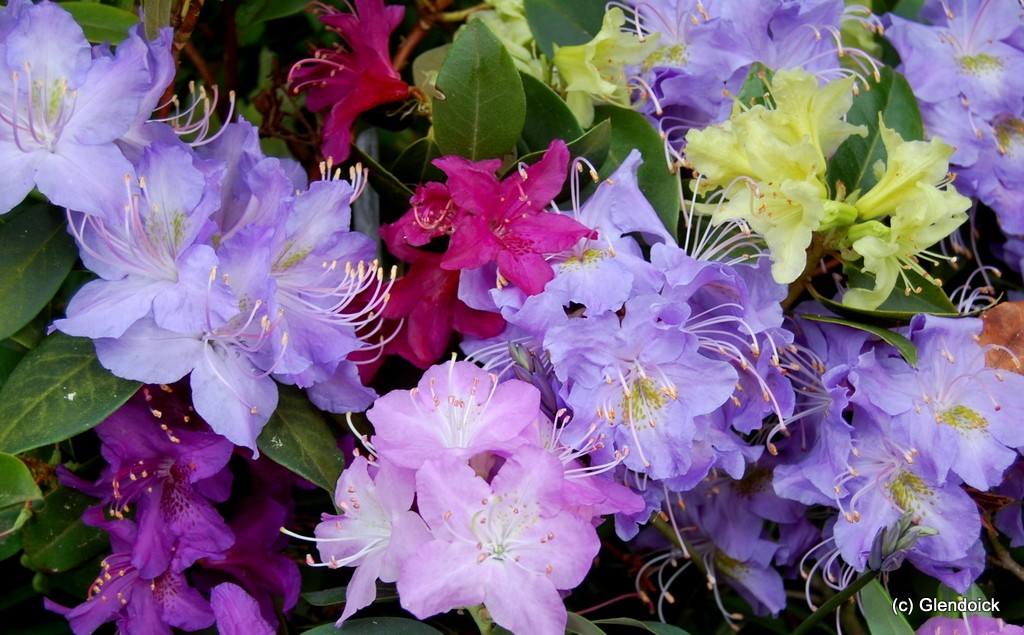
The last few summer in the UK have brought climate change to almost every gardener’s attention. Rhododendrons and azaleas are particularly sensitive to heat and drought as they are shallow rooted.
he choice of which varieties to plant and how to look after them will help your chances of success. I supplied many plant for the gardens at Fort Belvedere Windsor 10 years ago and went back to see how they were doing last year. Most were thriving which was very encouraging.
Challenges
Hotter summer temperatures and resulting soil temperatures.
· Spring and summer droughts for longer periods
· When rain comes it tends to be heavier, sudden thundery downpours which can flood beds, cause erosion and splash mud and disease spores onto foliage.
· Many rhododendron species come from mountainous, summer monsoon areas of the world, and thus tend to have cool summer temperatures. These species have little or no tolerance to prolonged summer heat. With there being over 700 temperate species, however, some rhododendron species, and to some extent likely their hybrids as well, are better able to tolerate prolonged summer heat than others.
Ken Cox advice to mitigate climate change
· Plant bareroot grown rhododendrons in Autumn and Spring so that they can begin root growth before the summer heat and drought arrives. Potted rhododendrons can take longer to establish. I know it is tempting to buy them in flower… but its not the best time to plant them….
· Certain subsections of species rhododendrons have very little heat tolerance. These include Campylocarpa (R wardii etc), Neriiflora (some species such as sanguineum have little or no heat tolerance). Section Pogonanthum species such as R primuliiflorum. Even at Glendoick where summers are still fairly cool, these species are proving tough to grow. I would tend to steer away from these in S England.
· Consider installing soaker hose irrigation. This is much less wasteful than sprinklers. The black porous hose leaks and drips water continuously along its length. It costs around £70 for 100m. It works with low water pressure and you can put it on a timer. You can even buy a solar timer which turns on the hose when it is sunny and turns it off when it is dull.
· Mulching can help keep the soil temperature down, especially with newly planted rhododendrons.
· Heavy rain and flooding can also be lethal, and if a concern, rhododendrons may need to be raised or planted on mounds, although this may make them more susceptible to drying out if in the summer. This is especially relevant for Subsection Maddenia rhododendrons, which are grown on well-draining, raised beds at Glendoick. Heavy rain events can occur in any season, so waterlogging can occur at any time of year when prolonged flooding and/or poor drainage occurs.
Choice of Plants for heat tolerance & strategies
· Rhododendron species from Japan (e.g., yaks (R. degronianum subsp. yakushimanum), northern China (e.g., R. fortunei), North America, Vietnam and the Caucasus are more adapted to hot, dry weather.
· Azaleas are generally pretty heat and drought tolerant as they come from Japan and N America.
· Hybrids in general are more robust and tolerant of less than ideal conditions. Yellow hybrids are the hardest to please.
· Rhododendrons from Section Rhododendron, Triflora (e.g., R. yunnanense, R. augustinii) and Maddenia (e.g., R. excellens, R. johnstoneanum, R. maddenii) subsections can show some drought tolerance once established.
· Greedy Trees Cedars, leylandii, beech, sycamore, camellias and magnolias will win the battle for water against the more shallow-rooted rhododendrons. Try not to plant rhododendrons where greedy roots will win the moisture battle
.
Hosepipe bans are likley to become more common in S.E. England and perhaps elsewhere. Cornwall, Wales, W Scotland and Irish gardens have usually worked on the assumption that enough rain will fall from the sky, so irrigation is seldom available. Recent summers have forced us to think again.
1. Select varieties with a degree of heat and sun tolerance: most hardy hybrid rhododendrons, most azaleas, dwarf rhododendron hybrids (but not species). Yellow flowered larger rhododendrons have less heat tolerance than other colours.
2. Triflora rhododendrons, Maddenia and azaleas are more tolerant of drought, once established, then species rhododendrons.
3. New plantings in particular will need to be irrigated in the first season or two. Mulching can help conserve water in the soil.
4. As well as sprinkers, consider using seep hose with tiny leaking along the whole length... or micro irrigation with small sprinklers which produce fine spray which leads to less wasteful run off.
5. Water can be recycled, if it runs downhill into a pond for example. But be aware that you can end up moving fungal disease around the garden if you are not careful.
6. Avoid planting under or near greedy trees like beech and sycamore. They will always win the battle for light and moisture. Camellias and magnolias are greedy and will tend to punish neighbouring shallow-rooted rhododendrons.
7. Grafted plants on rootstocks with heat and drought tolerance often produces more resiliant plants than those on their own roots.
8. If plants are badly burned don't panic. Water and liquid feed them... to encourage some new growth... and they will often recover fine.